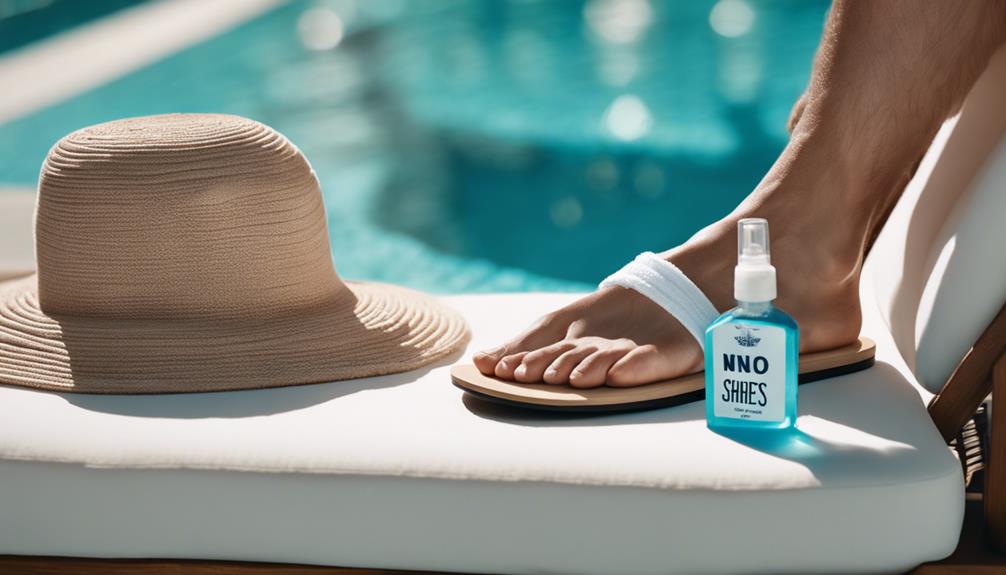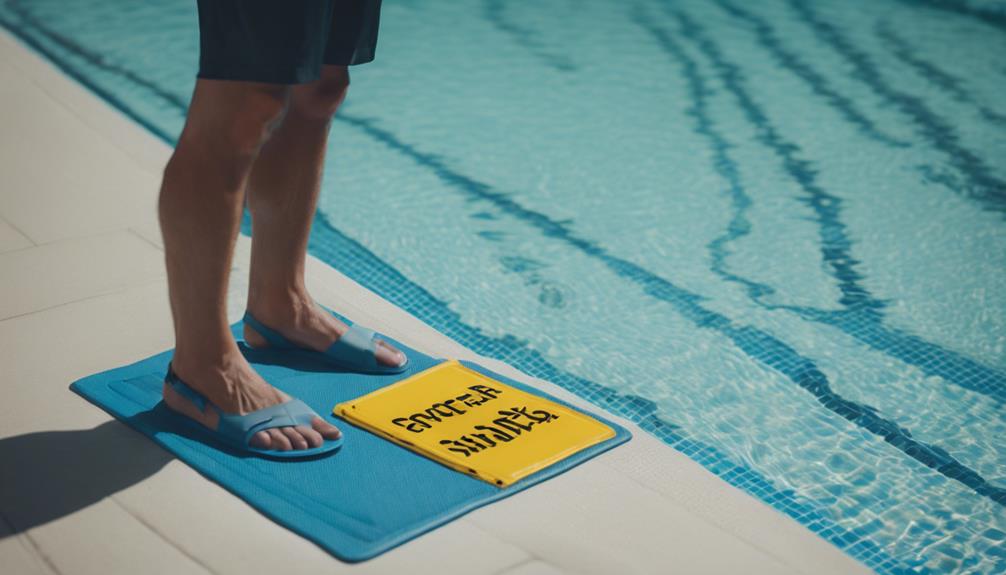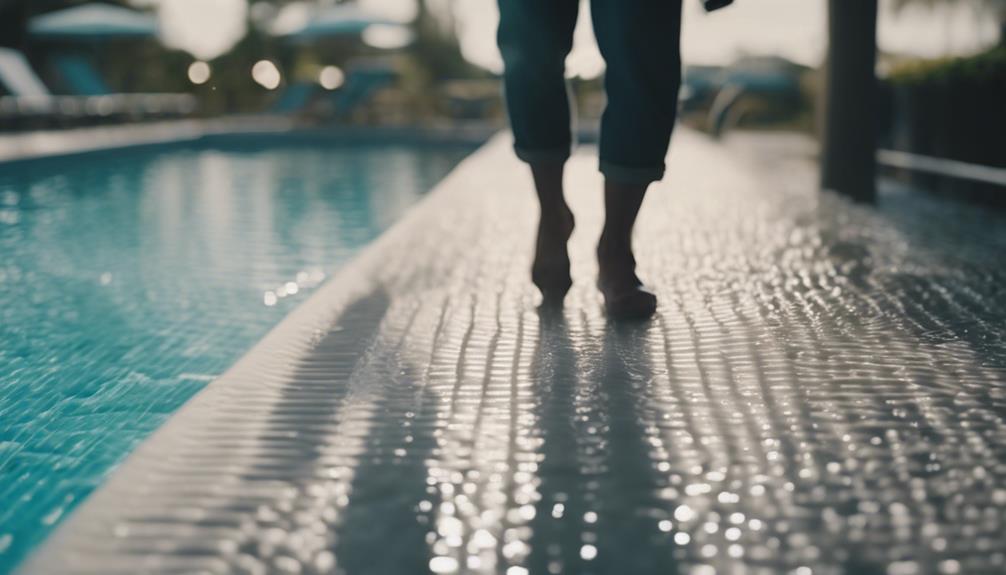Ensure your feet remain protected while at the pool by utilizing swim shoes to minimize the risk of cuts, infections, and slipping on wet surfaces. Before entering the water, inspect your feet for any cuts and ensure they are completely dry after swimming. To prevent fungal infections, always use your own towel and wash it regularly. Following your swim, wash your feet with clean water, paying special attention to the areas between your toes, and make sure they are thoroughly dry. Before swimming, remember to stretch to reduce strain on your feet, and keep yourself hydrated to prevent cramps. It is essential to prioritize foot hygiene and be mindful of your swimming technique to avoid injuries. Consider wearing water shoes or flip-flops to protect your feet from any contamination present on pool surfaces.
Key Takeaways
- Wear water shoes to prevent infections and slips.
- Check feet for cuts before swimming.
- Dry feet thoroughly after swimming.
- Stretch to reduce foot strain risks.
- Avoid walking barefoot on wet pool surfaces.
Common Foot Injuries at Pools
What foot injuries are commonly encountered at pools?
When at swimming pools, it's important to be aware of the common foot injuries that can occur. Plantar warts and athlete's foot are infections often contracted in such environments due to the warm and moist conditions. These conditions provide a breeding ground for bacteria and fungi, leading to foot discomfort and potential infections.
Additionally, performing swimming strokes and wall pushes can strain foot muscles, resulting in foot cramps and other related injuries. Walking barefoot on wet pool surfaces also poses a risk, increasing the chances of slips and falls, which can cause minor to severe foot injuries.
It's vital to be cautious and take preventive measures such as wearing water shoes, checking feet for cuts or blisters before entering the pool, and ensuring that your feet are dry post-swim. By being mindful of these common foot injuries, you can better protect yourself and enjoy a safer pool experience.
Choosing the Right Footwear

Consider wearing swim shoes to protect your feet effectively while at the swimming pool.
When choosing the right footwear for pool activities, keep in mind the following tips to guarantee maximum foot safety and comfort:
- Opt for swim shoes: These specialized shoes are designed to protect your feet from cuts, infections, and slips commonly found at swimming pools.
- Choose rubber-soled shoes: Look for swim shoes with rubber soles as they provide better traction on wet surfaces, reducing the risk of slips and falls.
- Ensure water-resistance: Select water-resistant footwear to prevent fungal infections like athlete's foot, which thrive in moist pool environments.
Towel & Pool Hygiene Tips

Using a personal towel at the pool is essential to prevent the spread of fungal infections.
Regularly washing your towels helps eliminate bacteria and germs that can lead to skin issues.
Remember to pat your feet dry thoroughly with a clean towel to avoid moisture-related foot problems.
Towel Cleanliness Importance
Regularly washing your towels is essential for maintaining proper hygiene at the swimming pool. Clean towels play an important role in preventing the spread of bacteria and fungi, ensuring a safe and healthy environment for all pool-goers.
Here are some important points to keep in mind regarding towel cleanliness:
- Preventing Skin Infections: Using a clean towel helps reduce the risk of skin infections that can result from bacteria lingering on dirty towels.
- Maintaining Hygiene: Regular washing of towels keeps them free from harmful bacteria, promoting good hygiene practices at the pool.
- Feeling Fresh: A fresh towel not only prevents the transfer of germs but also leaves you feeling clean and refreshed after your swim.
Feet Drying Techniques
After swimming, always make sure you carefully pat your feet dry with a clean, dry towel to prevent fungal infections. Moist environments, like those found at swimming pools, can harbor bacteria and fungi that thrive in damp conditions. By thoroughly drying your feet, you reduce the risk of developing conditions such as athlete's foot.
Remember not to share towels with others to avoid transferring any potentially harmful microorganisms. It's also a good practice to rinse off your feet with clean water after leaving the pool to remove any chlorine or other chemicals that could irritate your skin.
Ensuring your feet are completely dry before putting on socks and shoes is essential in preventing moisture-related foot issues. By following these foot care tips and maintaining proper pool hygiene, you can protect your feet from infections commonly associated with damp environments.
Post-Pool Rinse Off
Thoroughly rinse off your feet after leaving the pool to remove chlorine, bacteria, and other contaminants. Here are some essential steps to make sure your feet stay clean and healthy post-swimming:
- Use clean water: Wash your feet and between your toes with clean water to prevent infections and irritation.
- Dry completely: Be sure to dry your feet thoroughly, especially between the toes, to avoid fungal growth in damp areas.
- Pat dry gently: After rinsing, pat your feet dry gently with a clean towel to prevent skin irritation or damage.
Drying Techniques for Feet

After swimming, remember to thoroughly dry your feet to prevent fungal infections and skin irritation. Use a clean towel to gently pat your feet dry, ensuring you reach between the toes.
Avoid leaving your feet damp, as moisture can create an environment for bacteria and fungus to thrive.
Towel Drying Tips
To guarantee excellent foot hygiene post-swimming, employ efficient towel drying techniques to prevent fungal infections and moisture buildup.
Here are some towel drying tips to keep your feet dry and healthy after a day at the swimming pool:
- Always use a separate, clean towel specifically for drying your feet to avoid spreading bacteria and fungi.
- Make sure to gently pat your feet dry, paying extra attention to areas between the toes where moisture can accumulate.
- Confirm your feet are completely dry before putting on socks and shoes to prevent the growth of bacteria.
Air Drying Methods
When it comes to drying your feet after swimming, utilizing air drying methods is an important way to maintain foot hygiene and prevent fungal infections. Keeping your feet clean and dry is essential in avoiding issues like athlete's foot. Air drying allows excess moisture to evaporate naturally, reducing the risk of fungal infections.
Properly drying between your toes is particularly vital as it helps prevent conditions like athlete's foot and other foot infections. Instead of rubbing your feet vigorously with a towel, consider gently patting them dry with a clean towel to maintain foot hygiene at the pool. By allowing your feet to air dry without trapping moisture, you can prevent bacterial growth and skin irritation.
Thoroughly drying your feet after swimming not only enhances comfort but also plays a significant role in preventing fungal infections and maintaining overall foot health.
Footwear Selection Advice
For effective foot hygiene and moisture prevention, selecting swim shoes made of quick-drying materials is essential. When choosing your footwear for the pool, keep the following advice in mind:
- Quick-Drying Materials: Opt for swim shoes that are specifically designed to dry rapidly, reducing the risk of moisture buildup and the development of fungal infections.
- Non-Slip Soles: Look for swim shoes with non-slip soles to guarantee traction on wet surfaces, helping you avoid slips and falls that could lead to foot injuries.
- Breathable Designs: Consider swim shoes with breathable designs to promote airflow and keep your feet dry and comfortable, preventing discomfort and potential skin issues.
Hydration & Stretching Tips

Stay adequately hydrated before and after swimming to prevent foot cramps and dehydration-related injuries, ensuring peak foot performance at the pool. Essential hydration is important for maintaining foot health and overall performance in the water. Drinking enough water helps prevent muscle fatigue and supports your feet during swimming activities.
Additionally, stretching your feet and ankles before hitting the pool can enhance flexibility, reducing the risk of strains and injuries. Stretching is an essential practice that can also help in avoiding foot cramps and ensuring a more enjoyable swimming experience.
Preventing Strains & Injuries

To prevent strains and injuries while swimming, focus on proper warm-up techniques and maintaining good hydration levels. Stretching before entering the pool helps prepare your muscles and reduce the risk of foot strains. Additionally, staying hydrated and consuming foods rich in calcium can help prevent foot cramps during your swim.
Here are three key tips to avoid foot injuries:
- Pay attention to your swimming techniques to prevent overuse injuries and strains.
- Take regular breaks to prevent overexertion and listen to your body's signals.
- Wear swim shoes or water socks to reduce the risk of slips, falls, and related foot injuries.
Safety Measures for Pool Surfaces

Pay attention to the potential risks posed by pool surfaces, especially in tropical or humid climates where contagious bacteria and fungi can thrive. Pool surfaces can harbor harmful bacteria and fungi, increasing the risk of infections like athlete's foot and plantar warts caused by HPV.
To protect your feet, prioritize foot hygiene by washing them thoroughly after swimming and ensuring they're completely dry before wearing socks and shoes. Consider wearing water shoes or flip-flops around the pool to create a barrier between your feet and the potentially contaminated surfaces.
Additionally, avoid sharing towels to prevent the spread of infections. Remember to rinse off well after leaving the pool to remove any lingering contaminants.
Frequently Asked Questions
How to Treat Pool Feet?
To treat pool feet, start by cleansing them thoroughly with antibacterial soap and warm water to remove bacteria and fungi.
Use foot scrubs or pumice stones to exfoliate dead skin and prevent calluses.
After cleansing, apply a moisturizing foot cream or lotion to keep your feet hydrated and prevent dryness.
For cracked heels and rough skin, use healing balms or ointments to promote skin repair.
Maintain regular foot care routines to guarantee soft, healthy skin and prevent infections.
How to Avoid Foot Fungus at the Pool?
To avoid foot fungus at the pool, always wear flip-flops. Fungal infections thrive in warm, damp areas, like poolside.
Athlete's foot and plantar warts are common pool-related issues. These can cause itching, burning, and hard growths on your feet.
What Do You Wear on Your Feet in the Pool?
When hitting the pool, opt for swim shoes to safeguard your feet from rough surfaces and potential infections. Avoid going barefoot to dodge cuts, infections, and slips.
Choose pool shoes with non-slip soles for better traction and protection. Guarantee a snug fit to prevent blisters and discomfort.
Proper pool footwear acts as a barrier against athlete's foot and plantar warts. Prioritize foot safety and enjoy a worry-free swim.
How Can I Protect My Feet From Water?
To protect your feet while swimming, consider wearing swim shoes or water shoes to prevent cuts, scrapes, and infections. Applying waterproof sunscreen can shield your feet from sunburn and skin damage. After swimming, be sure to rinse your feet thoroughly to eliminate chlorine or bacteria. Avoid walking barefoot on wet pool decks to reduce slips and falls. Remember to regularly check your feet for cuts, blisters, or signs of infection for prompt attention.
Conclusion
In summary, prioritizing foot safety at the swimming pool is vital to prevent common injuries and guarantee a pleasant experience. Remember to choose appropriate footwear, maintain proper hygiene, and practice post-pool rinsing and drying techniques.
Stay hydrated, stretch regularly, and be mindful of strains and injuries. By following these safety measures and being cautious of pool surfaces, you can protect your feet and enjoy your time at the pool with peace of mind.










